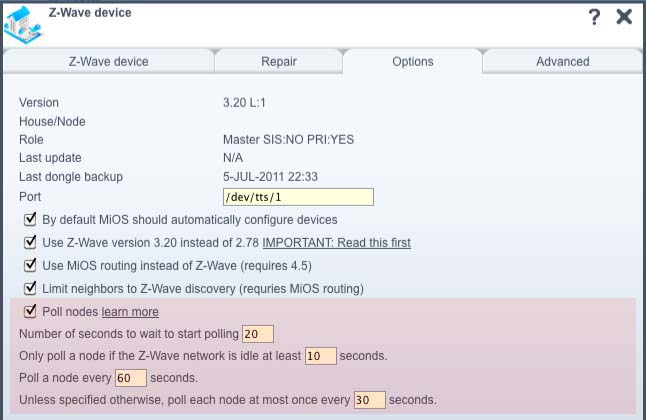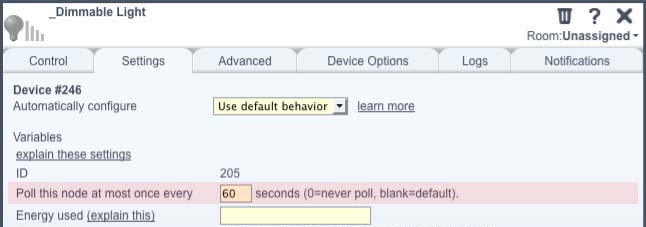Polling Settings
(Initial version) |
|||
| Line 5: | Line 5: | ||
Depending on the device, polling may not be necessary, as the device will report any status changes to Vera autonomously. Those devices are not normally polled, but only when Vera starts up. | Depending on the device, polling may not be necessary, as the device will report any status changes to Vera autonomously. Those devices are not normally polled, but only when Vera starts up. | ||
| − | Other devices, such as many battery operated sensors for example, will be in a | + | Other devices, such as many battery operated sensors for example, will be in a low-power state most of the time and therefore are not listening to the network and cannot be polled at all. |
<br> | <br> | ||
| − | The polling mechanism and the parameters that control it | + | The polling mechanism and the parameters that control it are described below.<br> |
| − | + | ||
| − | <br> | + | |
== Settings == | == Settings == | ||
| Line 19: | Line 17: | ||
[[Image:UI4-1.1.1245-Polling1.jpg|System-wide poll settings]] | [[Image:UI4-1.1.1245-Polling1.jpg|System-wide poll settings]] | ||
| − | *'''Poll nodes'''<br>Master switch to enable or disable polling.<br> | + | *'''(1) Poll nodes'''<br>Master switch to enable or disable polling.<br> |
| − | *'''Number of seconds to wait to start polling <#>'''<br>Number of seconds after Vera / the Luup engine has (re-)started before the polling mechanism begins.<br> | + | *'''(2) Number of seconds to wait to start polling <#>'''<br>Number of seconds after Vera / the Luup engine has (re-)started before the polling mechanism begins.<br> |
| − | *'''Only poll a node if the Z-Wave network is idle at least <#> seconds'''<br>Number of seconds Vera must not have transmitted any non-poll command before the next poll command is sent.<br> | + | *'''(3) Only poll a node if the Z-Wave network is idle at least <#> seconds'''<br>Number of seconds Vera must not have transmitted any non-poll command before the next poll command is sent.<br> |
| − | *'''Poll a node every <#> seconds.'''<br>Number of seconds between poll commands.<br> | + | *'''(4) Poll a node every <#> seconds.'''<br>Number of seconds between poll commands.<br> |
| − | *'''Unless specified otherwise, poll each node at most once every <#> seconds.'''<br>Minimum number of seconds between poll commands to the same node.<br><br> | + | *'''(5) Unless specified otherwise, poll each node at most once every <#> seconds.'''<br>Minimum number of seconds between poll commands to the same node.<br><br> |
The highlighted section in the screenshot below shows the poll settings per device.<br> | The highlighted section in the screenshot below shows the poll settings per device.<br> | ||
| Line 29: | Line 27: | ||
[[Image:UI4-1.1.1245-Polling2.jpg]] | [[Image:UI4-1.1.1245-Polling2.jpg]] | ||
| − | <br> | + | *'''(6) Poll this node at most once every <#> seconds'''<br>Minimum number of seconds between poll commands to this node.<br>Putting a '0' will disable polling for this node.<br>Leaving the field blank indicates the default value from the system-wide settings will be used. (See 'Unless specified otherwise...' above.)<br><br> |
| + | |||
| + | == Operation<br> == | ||
| + | |||
| + | If polling is enabled (1), Vera will begin polling when the Luup engine has restarted and the specified wait time (2) has elapsed. | ||
| + | |||
| + | The nodes are polled in sequence, starting with the lowest device number. The Z-Wave network must have been idle for the specified time (3), before the node is polled. | ||
| + | |||
| + | Once the node has been polled successfully, Vera waits the specified number of seconds (4) before polling the next node. | ||
| + | |||
| + | After all the nodes have been polled, the process repeats, taking into account the maximum poll rate (5)/(6) for each device. | ||
<br> | <br> | ||
| + | |||
| + | Devices that report their status autonomously and battery-operated devices that do no listen are skipped by default during normal operation. | ||
| + | |||
| + | == Example == | ||
| + | |||
| + | Typically, with the default settings and more than 2 'pollable' devices, a poll command will be sent every 30 seconds. | ||
| + | <pre>00:00 - Poll device #1 | ||
| + | |||
| + | 00:30 - Poll device #2 | ||
| + | |||
| + | 01:00 - Poll device #3 | ||
| + | |||
| + | 01:30 - Poll device #1 | ||
| + | |||
| + | ... | ||
| + | </pre> | ||
| + | == <span style="color: rgb(255, 0, 0);">Bug </span> == | ||
| + | |||
| + | <span style="color: rgb(255, 0, 0);">Currently (1.1.1245) the labels '''Poll a node every <#> seconds.''' and '''Unless specified otherwise, poll each node at most once every <#> seconds.''' are reversed.</span> So: | ||
| + | |||
| + | *The default value for '''Poll a node every # seconds.''' is 30; change this number to change the poll interval. | ||
| + | *The default value for '''Unless specified otherwise, poll each node at most once every <#> seconds.''' is 60; this this number to limit the poll rate of a single node. | ||
| + | *Bug# 1526. | ||
| + | |||
| + | == Change Log == | ||
| + | |||
| + | 2011/07/13 - oTi - Replace old info with updated UI4 description. Reformat page. [1.1.1245 / 3.20] | ||
[[Category:User_Instructions]] [[Category:Incomplete]] | [[Category:User_Instructions]] [[Category:Incomplete]] | ||
Revision as of 05:24, 13 July 2011
Contents |
Introduction
Polling is the process where Vera requests information from a Z-Wave device about its current status, such as on/off, dim level, temperature, and so on.
Depending on the device, polling may not be necessary, as the device will report any status changes to Vera autonomously. Those devices are not normally polled, but only when Vera starts up.
Other devices, such as many battery operated sensors for example, will be in a low-power state most of the time and therefore are not listening to the network and cannot be polled at all.
The polling mechanism and the parameters that control it are described below.
Settings
The highlighted section in this screenshot shows the poll settings for the entire system. They apply to all devices, unless specified differently for a specific device.
- (1) Poll nodes
Master switch to enable or disable polling.
- (2) Number of seconds to wait to start polling <#>
Number of seconds after Vera / the Luup engine has (re-)started before the polling mechanism begins.
- (3) Only poll a node if the Z-Wave network is idle at least <#> seconds
Number of seconds Vera must not have transmitted any non-poll command before the next poll command is sent.
- (4) Poll a node every <#> seconds.
Number of seconds between poll commands.
- (5) Unless specified otherwise, poll each node at most once every <#> seconds.
Minimum number of seconds between poll commands to the same node.
The highlighted section in the screenshot below shows the poll settings per device.
- (6) Poll this node at most once every <#> seconds
Minimum number of seconds between poll commands to this node.
Putting a '0' will disable polling for this node.
Leaving the field blank indicates the default value from the system-wide settings will be used. (See 'Unless specified otherwise...' above.)
Operation
If polling is enabled (1), Vera will begin polling when the Luup engine has restarted and the specified wait time (2) has elapsed.
The nodes are polled in sequence, starting with the lowest device number. The Z-Wave network must have been idle for the specified time (3), before the node is polled.
Once the node has been polled successfully, Vera waits the specified number of seconds (4) before polling the next node.
After all the nodes have been polled, the process repeats, taking into account the maximum poll rate (5)/(6) for each device.
Devices that report their status autonomously and battery-operated devices that do no listen are skipped by default during normal operation.
Example
Typically, with the default settings and more than 2 'pollable' devices, a poll command will be sent every 30 seconds.
00:00 - Poll device #1 00:30 - Poll device #2 01:00 - Poll device #3 01:30 - Poll device #1 ...
Bug
Currently (1.1.1245) the labels Poll a node every <#> seconds. and Unless specified otherwise, poll each node at most once every <#> seconds. are reversed. So:
- The default value for Poll a node every # seconds. is 30; change this number to change the poll interval.
- The default value for Unless specified otherwise, poll each node at most once every <#> seconds. is 60; this this number to limit the poll rate of a single node.
- Bug# 1526.
Change Log
2011/07/13 - oTi - Replace old info with updated UI4 description. Reformat page. [1.1.1245 / 3.20]

